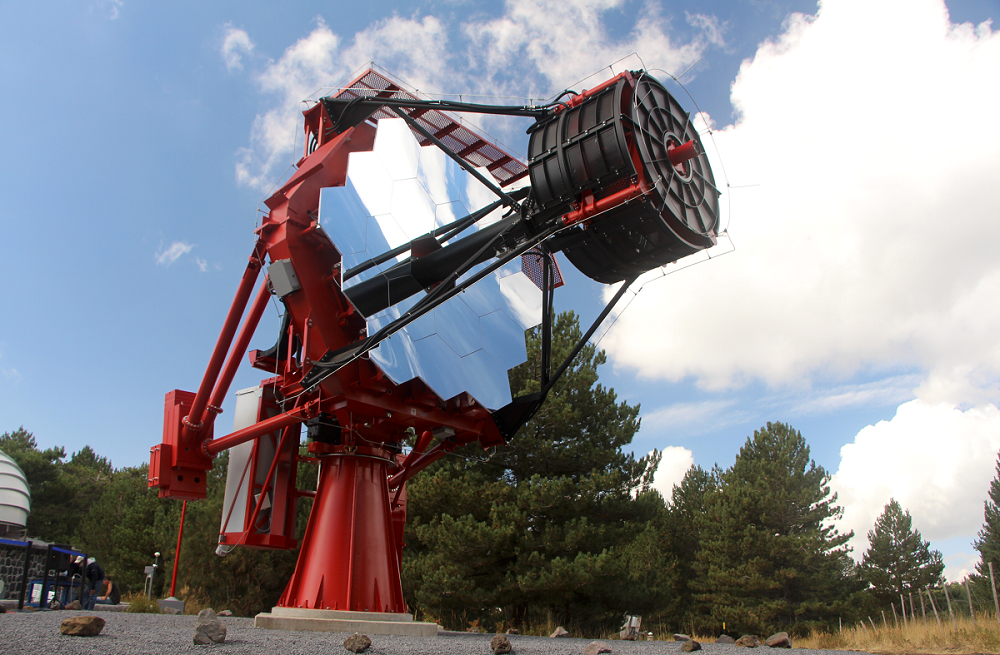In 2013, the
Cherenkov Telescope Array
(CTA) was established with the intention of building the world's largest and most sensitive high-energy gamma ray observatory. Consisting of over 1350 scientists from 210 research institutes in 32 countries, this observatory will use 100 telescopes across the northern and southern hemispheres to explore the high-energy Universe.
Key to their efforts is a prototype dual-mirror Schwarzschild-Couder telescope, known as the
Astrofisica con Specchi a Tecnologia Replicante Italiana
(ASTRI). Since it was first created in 2014, this prototype has been undergoing tests at the Serra La Nave Observing Station on Mount Etna, Sicily. And as of October of 2016, it passed its most important test to date, demonstrating a constant point-spread function across its full field of view.
The ASTRI telescope is essentially a revolutionary kind of
Imaging Atmospheric Cherenkov Telescope
(IACT). These ground-based telescopes are used by astronomers to detect cosmic high-energy gamma rays. These rays are produced by the most energetic objects in the universe (i.e. pulsars, supernovae, regions around black holes), and are only detectable because of the
Cherenkov Effect
, which they undergo once they pass into our atmosphere.
[caption id="attachment_131956" align="aligncenter" width="452"]
A IACT telescope at the Whipple Observatory, Mount Hopkins, Arizona. Credit: magic.mpp.mpg.de
[/caption]
This effect occurs when particles of light achieve speeds greater than the phase velocity of light in their particular medium. In this case, the effect is produced when light particles pass from the vacuum of space into our atmosphere, temporarily exceeding the speed of light in air and producing a glow in the blue to UV range. In the case of very-high-energy gamma rays, indirect observations of this Cherenkov radiation is the only way to detect them.
Typically, Cherenkov telescopes use a mirror to collect light and focus it on a camera. The ASTRI telescope is something quite different, in that it is based on the
Schwarzschild-Couder
model. As Giovanni Pareschi, an astronomer at the
INAF-Brera Astronomical Observatory
and the principal investigator of the ASTRI project, told Universe Today via email:
This idea for such a telescope was first proposed in 1905 by German astronomer Karl Schwarzschild, but remained dormant for almost a century since it was deemed too difficult and too expensive to construct. It was not until 2007 that it was considered as a viable means for creating a new type of IACT. And in 2014, the INAF-Brera Astronomical Observatory commissioned the first of its kind to be built.
[caption id="attachment_131957" align="aligncenter" width="580"]
Polaris, the North Star, as observed by ASTRI with different offsets from the optical axis of the telescope. Credits: Enrico Giro/Rodolfo Canestrari/Salvo Scuderi/Giorgia Sironi/INAF
[/caption]
"[W]e have for the first time adopted a two reflection design based on the Schwarzschild-Couder configuration never realized before (also for telescopes operating in the visible band)," added Pareschi. "This configuration allows us to optimize the angular resolution across the field of view and to use focal plane cameras of small dimensions (thanks to this property, we could use new solid-state technology based Silicon photomultiplier sensors instead of the "old" classical photomultiplier tubes used so far in Cherenkov astronomy)."
These advantages, and the advances they allow for, will make ASTRI telescope approximately ten times more sensitive than current instruments. And with this latest test - which demonstrating a constant point-spread function of a few arc minutes over a large field of view of 10 degrees - the team behind it now has proof that it will work. As Pareschi explained:
With this important test complete, the INAF-Brera team hopes to spend the next few months prepping the telescope. This will include mounting the Cherenkov camera onto the prototype and testing its gamma-ray performance. Then they will start to produce the first set of ASTRI telescopes to create a mini-array, which will serve as a precursor to the planned CTA sub-array that is scheduled to be built in Chile.
[caption id="attachment_129941" align="aligncenter" width="580"]
Artist's impression of a gamma-ray burst. Credit: ESO/A. Roquette
[/caption]
Once the camera is tested and mounted, the ASTRI team will conduct their first observations of gamma-rays at very high energies. These observations will allow scientists to determine the direction of gamma-ray photons that are the result of celestial sources, such as neutron stars, pulsars, supernovae, and black holes, tracing them back to their respective sources.
And with the planned construction of 100 SSTs to be spread out over the northern and southern hemispheres, the CTA array will outnumber all other telescopes in the world. The wide coverage and large number of these telescopes, spread over a wide area, will improve astronomers chances of detecting very high-energy gamma rays as they pass into our atmosphere.
Further Reading: CTA
 Universe Today
Universe Today
